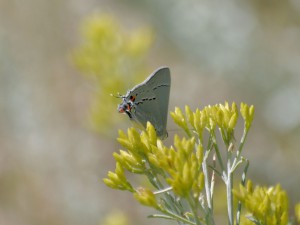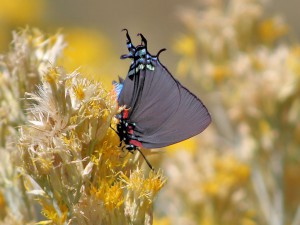Hairstreaks high-jacked us on a recent birding trip to Big Bear in the San Bernardino Mountains! Hairstreak butterflies are found in a variety of habitats here in southern California.
Gray Hairstreaks
On this trip, we found two species: the common Gray Hairstreak (Strymon melinus) and the rarer Great Purple Hairstreak (Atlides halesus). Gray Hairstreaks are one of the most widespread butterflies in North America, native to all lower 48 states, southern Canada and northern Mexico. Like most hairstreaks, the Gray tends to fold its wings when landing. Recognize this butterfly by the light gray coloration, prominent orange rectangle on the underside of the hind wing, and a line of dark spots on both fore and hind wings.
Little hair-like extensions of the hind wing rear margins form the “hairs” that give these butterflies their name. On Gray Hairstreaks, the hair is fairly prominent; it is much less so on some other members of the family, like the Elfins or the Hedgerow Hairstreak.
Great Purple Hairstreak
The Great Purple Hairstreaks are larger and altogether flashier butterflies than Gray Hairstreaks. This butterfly is just awash in color, being iridescent deep purple or dark blue on the upper wing surfaces, and matte purplish-gray with red, white, pale green and metallic sky blue accents on the under wing surfaces. Even more startling is the abdomen, which is bright orange on the underside and sky blue on the upper surface. This is a gaudy little butterfly! Great Purple Hairstreaks show very prominent “hairs”, with curled and elaborate shape.
We found both species of hairstreak nectaring on rabbitbrush flowers (Chrysothamnus nauseosus) along the shore of Big Bear Lake. Evidently, this was a good source of nectar as we saw a wide variety of insects on these flowers. But the Great Purple Hairstreak held our attention, and we want to thank Allie, for putting us onto it.
Interestingly, significant behavioral differences distinguish these two hairstreak species. Though Gray Hairstreaks often occur in numbers, with multiple individuals together on low plants. Great Purple Hairstreaks, by contrast, are solitary. Seldom found near ground level, Great Purple Hairstreaks prefer to perch high in the branches of trees. Thus it was a great pleasure to find one in such a conveniently viewable perch. The bright colors and subtle markings of these two butterflies make you really appreciate the sharpness and close-focus ability of great optics. The Zeiss Victory HT binocular with its 6-foot close focus performed superbly here.


